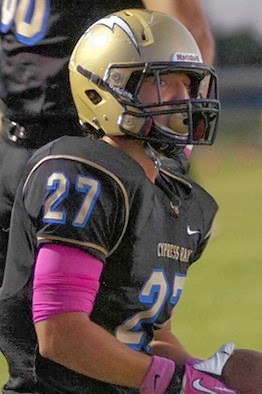Good news for young athletes! Hospitals in the US now provide more sports medicine programs that are tailored for kids. According to The Wall Street Journal,
the new surgical techniques and physical therapy protocols aim to protect the growing bones of young patients and to provide them with encouragement and support, especially if they are "upset to be sitting out of a beloved sport." Read the full report below.
(Kaylyn Lambertt, a high-school soccer player and now a freshman at Florida State University, had surgery on her left hip her junior year and her right hip her senior year. Leslie Russell) Image Source: online.wsj.com
Children's hospitals are expanding programs to care for a fast-growing category of young patients: injured athletes.
The rehabilitation needs of children and teens are different than those of adults. More sports medicine programs are working exclusively with young athletes, using surgical techniques and physical therapy protocols that don't interfere with growing bones and cartilage.
One aim of this is to prevent affecting the growth plate—the area of growing tissue near the end of long bones in children and teens. For example, while adults may lift heavier weights to build muscle during physical therapy, pediatric patients may do higher repetitions with lower resistance to avoid hurting growing bones, muscles and tendons. The programs also offer encouragement and support for kids upset to be sitting out of a beloved sport.
More than 3.5 million children a year receive treatment for sports injury, according to Stop Sports Injuries, a campaign whose backers include the American Orthopaedic Society for Sports Medicine. And high-school athletes account for an estimated 2 million sports injuries each year. While concussions account for about 15% of youth sports injuries, experts say many sports carry risks for musculoskeletal injuries, in large part due to increased emphasis on year-round competition, single-sport concentration and intense training regimens.
A study published last year by Boston Children's Hospital warned that children of all ages are sustaining significant sports injuries that require surgical intervention. "In the past we'd put a cast on a broken leg, take it off six to 13 weeks later and send kids home," says Lyle Micheli, director of the hospital's division of sports medicine. "Now we realize we have to very systematically rehabilitate these kids for strength and basic function, and determine when it is safe for them to return to play."
While injuries from recreational activities such as biking have fallen over the last decade, team sports including football and soccer saw injuries rise by 22.8% and 10.8% respectively, according to a study last year by Cincinnati Children's Hospital Medical Center.
Doctors are seeing more overuse injuries. There has been a fivefold increase since 2000 in the number of shoulder and elbow injuries among youth baseball and softball players, according to Stop Sports Injuries.
Children's Hospital & Research Center Oakland, in California, last fall opened a Sports Medicine Center for Young Athletes at its Walnut Creek campus. "It's hard for kids to do rehabilitation next to an 85-year-old stroke victim or a 75-year-old cancer patient," says Nirav Pandya, the center's director, and an orthopedic surgeon. The center and many other pediatric clinics offer classes and programs to help kids improve sports performance while avoiding injury.
Physical therapy after injury and surgery, such as repair to the anterior cruciate ligament in the knee, is covered by insurance for varying periods. After that, clinics may design a regimen children can perform at home or at a local fitness facility.
Jeremy Frank, a pediatric orthopedic surgeon at Memorial Healthcare System's Joe DiMaggio Children's Hospital in Hollywood, Fla., says that there is often little pain a week after minimally invasive ACL surgery, so young people "think they are good to go and don't realize they have six months of rehabilitation in front of them." Often, he says, there is a "bargaining moment" where his young patients try to get him to approve more activity than they are ready for. Patients are generally referred to Memorial's two U-18—for Under 18—physical rehabilitation clinics in Coral Springs, Fla., where therapists work with families and coaches to stress the importance of healing.
Dr. Frank, U-18's assistant director, says while the vast majority of athletes get back to sports and do well, there are times when a young patient sustains multiple injuries such as a third ACL tear. "You have arthritic changes in your knee, and you have to stop playing soccer," he says.
Dylan Rupert, 17, a running back and captain of the Cypress Bay High School football team in Weston, Fla., tore his ACL during play last fall. His parents opted for a repair technique, which surgeons are more often using in pediatric patients. The procedure avoids drilling through the growth plate and may decrease risks of future pain and re-injury. The surgery used part of Dylan's own hamstring rather than a cadaver tissue more commonly used in adults. He started rehab at Coral Springs three days after his Oct. 22 surgery.
The injury was devastating for Dylan. It came just as he was getting the attention of college coaches, says his mother, Monica Puga-Finch, an information technology program director at the clinic's parent Memorial. In his first physical therapy session, senior therapist Whitney Chambers helped calm his fears, but "told him that she was going to push him, and he couldn't say 'I can't.' " As the sessions continued twice a week he would often come out sweating and sore but excited, "with a sense of accomplishment," Ms. Puga-Finch says. Ms. Chambers helped with the emotional aspects of being sidelined, encouraging him to go to practices and games with his team. His rehabilitation is expected to take six to eight months. He plans to return to sports in college.
Ms. Chambers says physical therapy after the growth-plate sparing procedure is more conservative than for the traditional ACL reconstruction. It starts with protective weight bearing exercises using crutches and a knee brace, gentle range of motion work, and ice and electrical stimulation for swelling and pain control. Then she works on strengthening muscles and restoring joint flexibility. To make it more fun, she uses games or obstacle courses.
The clinic uses screening questionnaires to identify kids at risk of depression, who may be referred to a child psychologist.
Kaylyn Lambertt who has played soccer from the age of 6, was a junior in high school when she felt a searing pain in her left hip during a game in December 2010. She continued to play for months as it got worse. Her labrum, part of her hip joint, was torn in two places, with a socket out of place. A lump on her bone was wearing down the cartilage every time she walked or ran. She had surgery to repair the damage in 2011, followed by months of rehabilitation with Ms. Chambers.
She returned to soccer her senior year, but began feeling pain, this time in her right hip. Dr. Frank told her that she had torn the labrum. She underwent a second surgery in December 2012. She returned to Ms. Chambers and realized during their talks that "soccer isn't everything." Now a freshman at Florida State University she plays a pickup game of soccer now and then, but is focused on what Ms. Chambers inspired her to chose as a career: physical therapy.
(Dylan Rupert, 17, of Weston, Fla., had surgery to repair a torn ACL last fall. I Three Photography) Image Source: online.wsj.com
Brittany Perskin here, your child-friendly physical therapist in Los Angeles, CA. Follow me on Twitter for more updates on physical therapy and sports medicine.










